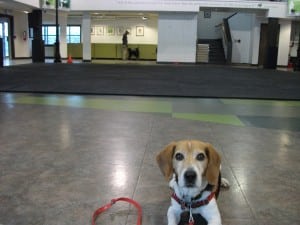After nearly a year hiatus, I’m taking dog training classes again as a student with Petey. Renee at All About Dogs is offering daytime agility classes, so finally, I was able to sign up and enroll in classes that didn’t conflict with when I teach in the evenings. Because of this, I’m inspired to start a short blog series on my experience as a dog training student in a mainstream dog training class, and share my approach to maximizing my dog’s ability to learn and perform.
The Story Begins a Year Ago:
Petey’s story with agility class actually starts a year ago, when I originally enrolled him for classes. After his rescue and transfer to our home (as a foster dog), he had completed a basic obedience class at Who’s Walking Who (where he was awarded the “Top Dog” award; I didn’t mention that I was a professional dog trainer – I just needed a place to train him around other dogs), and he was my Karen Pryor Academy dog. I imagined him taking agility classes, being focused and motivated (as he had been up till this point), and having him flying through weaves and tunnels in no time.
On the night of his first original class a year ago, we were early and settled into class. Renee had the dogs in class lay down on mats and work on stay exercises. Everything was going grand until after ten minutes into class, a late arrival entered through the doors. The late arrival was an adolescent male (intact I think) Portuguese Water Dog. For some reason, Petey was fixated on him and extremely frustrated by his arrival. He was desperate to go check out the dog, but of course, as class had started, dogs could not meet (like they originally had in the waiting area).
Quickly, Petey’s arousal levels increased to the point where he would no longer take food. He was visibly stressed and began howling and lunging, and if I recall correctly, he began air biting in frustration. In despair, I ran out of the classroom to give Petey some fresh air (not even having time to put my shoes on) and was outside in the rain in my socks. Coincidentally, I ran into Julie who had arrived early for the next class with her dog, Delilah. When she asked how I was doing, embarrassingly, I replied,
“Umm… I’ve been better. Petey is having a meltdown!”
After class one ended, I pulled Petey out of class immediately, and I’ve been at work ever since.
Lesson Learned: Wax On, Wax Off – Foundation Skills Are Everything. Without Them, You Have Nothing
At this time last year, Petey knew a ton of cool behaviors, like his jump in a box trick, lots of targeting behaviors, and we had even begun working on object discrimination exercises. He knew how to target post-it notes, sit pretty, jump over, through my arms and legs, and much more. Big deal! He was unable to focus in class as soon as a curly, black colored dog with testicles came into the room. Prior to this, in his limited experiences in different classroom settings, perhaps I had just been lucky that none of the dogs were black with curly hair, and were all neutered.
Over the last year, Petey has actually learned very few new behaviors. Other than hind-end awareness exercises, which I just did over the winter recently, I have only been working on a single behavior: Eye contact. This is the first exercise we work on in puppy class at When Hounds Fly. I spent a year on this single exercise with Petey, the dog that learned all the behaviors taught in the Karen Pryor Academy curriculum.
In class at When Hounds Fly, I make my students do a ton of eye contact exercises. It is boring and repetitive, but it is important. Focus and attention work is the “Wax On, Wax Off” exercise of dog training. If you struggle to get your dog’s attention in class, or in other environments where your dog must perform reliably, it is absolutely critical to get that focus first before you even begin teaching any other behavior.
In Karate Kid, Daniel had to do four exercises before his karate training began. They were:
- Wash a parking lot of cars and wax them.
- Sand a huge wood deck.
- Catch flies with chopsticks.
- Paint a fence only using his wrists.
Over the last year, here are some of the eye contact exercises I have been working with Petey on:
- Long duration eye contact (1 minute+ duration built up)
- “Look at that” exercise with every single dog he has seen while on leash in a year (average of 6 dogs per day, which means over 2100+ repetitions in the last year)
- Zen, with food thrown right next to him, while holding position and reinforced for eye contact.
- Remedial socialization at the dog park, using protocols from Jean Donaldson’s FIGHT!
- Generalization – training on our walks, at multiple dog parks, on the street car, bus, and subway, at Pawsway, at pet supply stores, at the vet’s office, at When Hounds Fly (hence the purpose of Petey Needs Training classes last year) – everywhere, and anywhere.
In case you didn’t watch Karate Kid, here’s Daniel doing his foundation skills work:
This time around, we were ready for classes again. It was a year of prep work. In preparation for our first class, we moved onto the next foundation skill Petey would need to succeed in class – a fluent Go to Mat behavior – retrained at the dog park, with dogs, children, and adults milling about.
Lesson Learned: Get Real! (Expectations)
Last year in puppy class at When Hounds Fly, a student just finishing puppy class asked me whether it was necessary for his dog to take our basic foundation skills class, since he had already taught his dog a stay, and the dog knew how to sit and lay down. He emphasized how smart his puppy was and how his puppy should be doing agility.
Meanwhile, his dog was straining at the end of his leash, desperately trying to go visit the other puppies in class, and was completely unresponsive to his handler’s calls. Absolutely no sign of cognitive dissonance – just the blinders that go on when you’re a proud puppy parent, I guess.
Agility is new to me, but I get the feeling that agility instructors must get a lot of phone calls and emails from proud puppy parents asking to allow their dog to enter their agility programs, even though their dogs have had absolutely no foundation training. Or, they take agility classes, but disregard the foundation exercises (zen, mat, hind end awareness, etc.) and believe their puppy should be doing weaves and a-frames on first class.
Walking around a wet parking lot in my socks was the best thing that could happen to me. That experience gave me the motivation to spend a year on a single behavior. I estimate I have reinforced Petey over 10,000 times for eye contact in the last year, if not more. It forced me to get real with my own expectations on how much foundation work must be done before one even begins actually training a dog for a specific purpose. For example, in Bertilsson/Vegh’s Agility Right From The Start, the first time any specific agility equipment is introduced in their book is on page 263 (of a 440 page book). Everything prior to that is foundation skills.
For giggles, and to develop a little sympathy for agility/rally/obedience instructors, check out this video of a “proud puppy parent” and an agility instructor:
“My dog is far too brilliant to be in a beginner’s foundation class! Let’s just put him on the equipment and let him figure it out himself. All I have to do is point at the equipment and he will do it.”
Next Post: Preparing for Class
In my next post, I’ll talk about how I prepare for classes to make the most out of every second I’m there. And.. in case you’re wondering, Petey did great when he finally made his return to All About Dogs last week. And, very appropriately, the dog that was next to him in class was another black, curly furred Portuguese Water Dog, that Petey couldn’t care less about.

